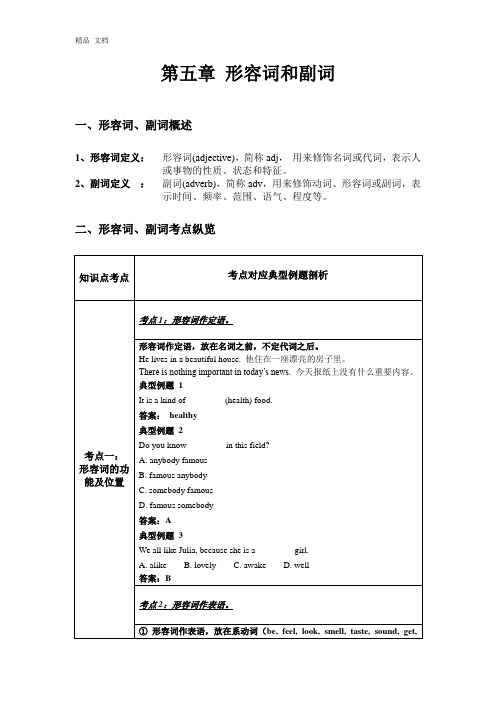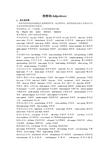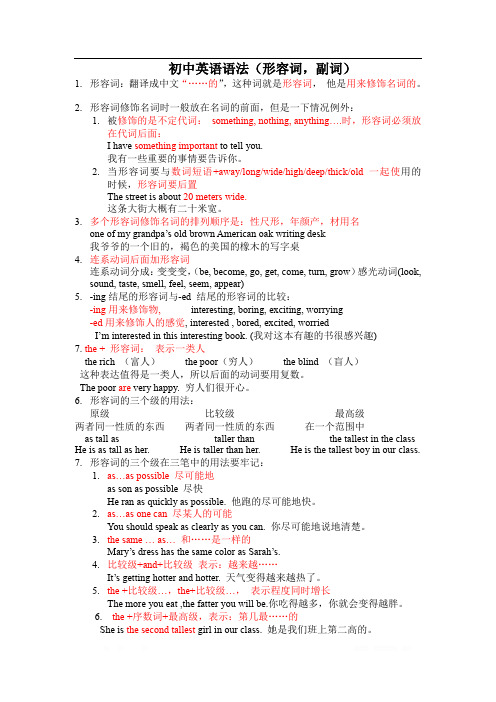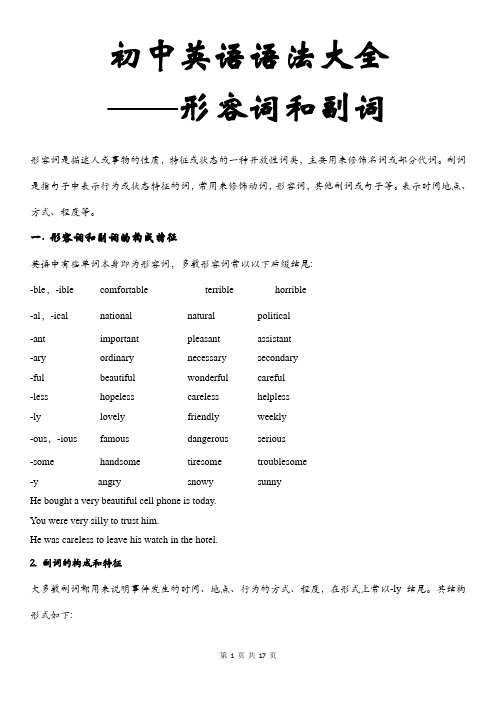初中英语语法大全:形容词和副词
初一英语形容词和副词语法知识总结(讲解+考点+综合练习):形容词和副词

第五章形容词和副词一、形容词、副词概述1、形容词定义:形容词(adjective),简称adj,用来修饰名词或代词,表示人或事物的性质、状态和特征。
2、副词定义:副词(adverb),简称adv,用来修饰动词、形容词或副词,表示时间、频率、范围、语气、程度等。
二、形容词、副词考点纵览三、综合练习( )1. –If you don’t like the red coat, how about the green one?–OK, but do you have _______ size in green? This one is a bit small for me.A. a bigB. a biggerC. the bigD. the bigger( )2. –Mum, I think I’m _______ to get back to school.–Not really, my dear. You’d better stay at home for anoth er day or two.A. so wellB. so goodC. well enoughD. good enough ( )3. –What delicious cakes! –They will taste _______ with butter.A. goodB. betterC. badD. worse( )4. –Mr. Zhou , of all the students in our group, who lives _______ ?–I think Li Lei does.A. farB. fartherC. farthestD. the farther( )5. With a history of more than 1,400 years, ZhaoZhou Bridge is the _______ stone arch bridge in the world .A. oldB. olderC. oldestD. elder( )6. Bob never does him homework _______ Mary. He makes lots of mistakes.A. so careful asB. as carefully asC. carefully asD. as careful as ( )7. A: How can I speak English _______ you?B: You’d better speak more, I think.A. as good asB. more thanC. as well asD. as much as( )8. Your English is good. I’ll try my best to speak it as _______you do.A. clearly asB. clear asC. clearer thanD. more clearly ( )9. –Is your mother badly ill?–No, _______ , only a little cold.A. serious anythingB. serious nothingC. nothing seriousD. anything serious( )10. I’m not sure if I’m going to Tim’s party; I may go to the concert _______ .A. onlyB. insteadC. earlyD. late( )11. Although they are brothers, they are the _______ opposite of one another.A. veryB. justC. fewD. little( )12. The new Bright Restaurant is _______ than the old one. Moore and more people like to eat there.A. goodB. betterC. badD. worse( )13. Wang Ping does _______ in physics that I missed the first class.A. badlyB. Most badlyC. worseD. worst( )14. I got up so _______ this morning that I missed the first class.A. earlyB. lateC. quietlyD. neatly( )15. –Do you enjoy traveling by plane?–No. It’s _______ expensive.A. much moreB. more muchC. too muchD. much too( )16. I’m afraid the headmaster is _______ busy to meet the visitors.A. too muchB. much tooC. so muchD. much too( )17. How beautifully she sings! I’ve never heard _______ .A. the better voiceB. a good voiceC. the best voiceD. a better voice( )18. You do well in your lessons. I’m _______ you will pass the exam.A. sureB. afraidC. sadD. sorry( )19. –Who is _______ in your class?–Fred.A. tallB. tallerC. tallestD. the tallest( )20. –What do you think of the football match?–Wonderful! The Chinese football team has never played _______ .A. betterB. bestC. worseD. worst( )21. The population of China is _____ than _____ of any other country in the world.A. larger , the oneB. more , thatC. larger , thatD. more , the one ( )22. There is much wine here, but _______ people want to drink it.A. manyB. a littleC. fewD. a few( )23. People speak ______ of the film Not One Less. It is really necessary for every child to go to school.A. loudB. loudlyC. highD. highly( )24. She always finishes her homework on time. She ______ leaves it for tomorrow.A. alwaysB. neverC. usuallyD. sometimes( )25. The football match was _______, so the boys were _______ about it.A. excited , excitingB. exciting, excitedC. excited , excitedD. exciting , exciting( )26. Playing table tennis isn’t difficult. You can learn it _______.A. easyB. easilyC. quickD. hardly( )27. We Chinese always put our family name _______.A. lastB. nearlyC. firstD. in the middle ( )28. This kind of T-shirt look _______ and sells _______ in the market.A. nice, goodB. well , wellC. nice , wellD. good , nice( )29. The light in the room wasn’t _______ for me to read.A. brightly enoughB. enough brightlyC. enough brightD. bright enough( )30. –Look, this digital camera is really cheap! It’s only five hundred yuan.–The _______ , the better. I’m short _______ money, you know.A. cheaper , ofB. cheap, forC. expensive , ofD. more expensive , for( )31. Which subject do you like _______ , math, Chinese or English?A. betterB. bestC. wellD. very much( )32. _______ little water is not enough for _______ many people.A. Such , soB. So , soC. Such , suchD. So , such( )33. English is spoken by _______ people.A. a lotB. much manyC. a large number ofD. a great deal of ( )34. –Isn’t that Mary?–Yes, she always has a(an) _______ smile on her face.A. aloneB. kindlyC. ownD. friendly( )35. –Do you prefer music to drawing?–No. I like drawing _______.A. wellB. mostC. betterD. best( )36. Since China has been a member of the WTO, English is ______ useful than before.A. moreB. mostC. muchD. very( )37. Can you speak a little louder? I can _______ hear you.A. hardB. reallyC. hardlyD. clearly( )38. China has a _______ population and long history.A. manyB. largeC. muchD. big( )39. Do you have _______ to say?A. important anythingB. anything importantC. important somethingD. something important( )40. Which is _______ , English or Chinese?A. interestingB. interestingerC. more interestingD. most interesting( )41. –The TV programme is boring. Shall we play chess intead?–All right. That is _______ than watching a boring programme.A. very goodB. much goodC. very betterD. much better( )42. –Mum, could you buy me a dress like this?–Certainly, we can buy _______ one than this, but _______ this.A. a better, better thanB. a worse , as good asC. a cheaper , as good asD. a more important , not as good as ( )43. Let’s enjoy the song Yesterday Once More. It sounds _______.A. wellB. sadlyC. niceD. bad( )44. –Is the physics problem _______ ?–Yes. I can work it out _______.A. easy , easilyB. easy, easyC. easily , easyD. easily , easily ( )45. Hainan is a very large island. It’s the second _______ island in China.A. largeB. largerC. largerD. most large( )46. What a _______ cough! You seem _______ ill.A. terrible, terriblyB. terribly , terribleC. terrible , terribleD. terribly , terribly ( )47. I’m not sure whether Mary can sing _______ Mabel.A. as well asB. as good asC. so good asD. as better as( )48. Chinese is _______ more difficult than English.A. mostB. veryC. manyD. much( )49. The _______ old man told his son to be a good boy.A. diedB. deadC. dyingD. death( )50. Today my sister is feeling _______ to go to the factory.A. enough goodB. good enoughC. well enoughD. enough well参考答案精品文档1—5 B C B C C6—10 B C A C B11—15 A B D B D16—20 B D A D A21—25 C C D B B26—30 B C C D A31—35 B B C D C36—40 A C B B C文档说明(Word文档可以删除编辑)专注于精品文档:中考、高考、数学语文英语试卷、高中复习题目、小学试卷教案合同协议施工组织设计、期中、期末等测试,本文档目的是为了节省读者的工作时间,提高读者的工作效率,读者可以放心下载文档进行编辑使用.文档来源网络改编,审核有可能疏忽,如果有错误或侵权,请联系本店马上删除。
初中英语语法--形容词和副词

形容词(Adjectives)I.定义及分类形容词是用来说明或描述人或事物的性质、状态等的词。
就其构成形式而言,形容词可以分为单词形容词和复合形容词。
单词形容词:由一个词构成,可以带前缀或者后缀。
big diligent pale square dishonest impatient复合形容词:由两个或更多的词构成。
名词+形容词:sea-sick 晕船的air-sick 晕飞机的ice-cold 冰冷的duty-free 免税的snow-white 雪白的blood-thirsty 残忍的world-wide 世界性的shake-proof 防震的water-tight 不漏水的knee-deep 及膝的toll-free 免利息的top-heavy 头重脚轻的名词+名词-ed:iron-willed 意志坚强的ox-eyed 大眼睛的honey-mouthed 甜言蜜语的apple-shaped 苹果形状的lion-hearted 勇敢的silver-haired 银发的hook-nosed 勾鼻子的名词+现在分词:law-abiding 守法的time-consuming 耗费时间的self-sacrificing 自我牺牲的peace-loving 爱好和平的face-saving 顾面子的English-speaking 讲英语的pleasure-seeking 寻欢作乐的heart-rending 令人心碎的soul-stirring 感人肺腑的epoch-making 划时代的man-eating 吃人的fault-finding 喜欢挑剔的labor-saving 节省劳力的mouth-watering 令人垂涎的名词+过去分词:weather-beaten 饱经风霜的heart-felt 衷心的heart-broken 伤心的hand-made 手工的home-made 本国造的state-owned 国有的sugar-coated 糖衣的tongue-tied 结结巴巴的形容词(数词)+名词:long-distance 长途的fine-manner 举止优雅的present-day 当前的five-year 五年的bare-foot 赤脚的first-rate 一流的second-rate 二流的first-class 头等的deep-sea 深海的half-price 半价的one-way 单向(通行)的part-time 兼职的形容词(数词)+名词-ed:white-haired 白发的round-faced 圆脸的double-faced 两面派的teen-aged 十几岁的good-mannered 有礼貌的bad-tempered 坏脾气的narrow-minded 心胸狭窄的noble-minded 品格高尚的kind-hearted 心地善良的absent-minded 心不在焉的smooth-tongued 花言巧语的short-sighted目光短浅的near-sighted 近视的simple-minded 头脑简单的tight-fisted 吝啬的far-sighted 眼光远大的warm-hearted 热心的形容词+现在分词:good-looking 好看的sweet-smelling 好闻的easy-going 随和的thorough-going 彻底的fine-sounding 好听的形容词+过去分词:high-born 出身高贵的ready-made 现成的ready-cooked 烧好的native-born 本地生的new-built 重建的副词+形容词:ever-green 常青的all-round 全能的,全面的over-busy 太忙的over-credulous 过于轻信的over-critical 过于挑剔的(=hypercritical)副词+名词:off-hour 休息时间的off-guard 失去警惕的off-campus 校园外的off-key 不协调的off-budget 预算外的on-line 在线的副词+现在分词:ever-lasting 持久的on-coming 迎面而来的up-coming 即将来临的well-meaning 善意的far-reaching 深远的ever-increasing 不断增加的never-ending 不断的high-ranking 高级的副词+过去分词:well-known 著名的ill-mannered 举止粗鲁的well-behaved 表现好的well-informed 消息灵通的well-balanced 平衡的well-dressed 穿着时髦的badly-wounded 重伤的wide-spread 广泛流传的newly-built 新建的widely-used 广泛使用的well-equipped 装备精良的newly-married 新婚的形容词+形容词:red-hot 炽热的dark-green 深绿的bloody-red 血红的过去分词+介词:unthought-of 没有想到的unpaid-for 没付款的undreamed-of 连做梦也没想到的longed-for 渴望的uncalled-for 未被请求的unlooked-for 非期待的most-talked-about 谈得最多的yet-unheard-of 尚未听说过的(unheard-of=unprecedented)动词(过去分词)+副词:carry-on 随身携带的built-in 嵌入的cast-off 丢弃的drive-in 开车进去的unlived-in 没人住的其他类型:heart-to-heart 推心置腹的well-to-do 富裕的well-off 富裕的down-to-earth 讲究实际的life-and-death 生死攸关的根据其句法功能可以分为定语形容词,表语形容词和通用形容词:定语形容词:1. 起强调作用或特指作用的形容词: actual age chief cause main idea mere child only reason principal food sheer nonsense sole purpose total number2. 由名词转化而来的形容词:atomic energy, criminal law golden opportunity medical college表语形容词:1. 某些以a-开头的形容词: afraid alert alike alive alone aloof ashamed asleep astir awake aware2. 表示健康状况的形容词: faint ill well unwell注:ill作定语时,意为“坏的,邪恶的,恶劣的”如:ill luck/name/news/temper/wound等。
初中英语语法之形容词,副词

初中英语语法之形容词&副词初中英语语法之形容词&副词形容词副词的原级、比较级和最高级1、分类:形容词和副词有原级、比较级和最高级三级。
2、规则变化:(1)单音节和部分双音节形容词和副词,在原级的后面加上er,est构成比较级和最高级。
a)直接加er,est :b)以重读闭音节结尾的,要双写最后一个辅音字母,后加er,est:c)以辅音字母+y结尾的,先把y改为i再加上er,est:(2)两个音节或两个以上的音节的,在原级前加more / most.3、不规则变化:原级比较级最高级good好的better更好的best最好的well好;(身体)好的,bad,badly糟糕的,糟糕地worse更糟糕的,更糟糕地;(身体)更不舒服的worst最糟糕的,最糟糕地;(身体)最不舒服的ill(身体)不舒服的many许多的(可数)more更多的;更most最多的;最much许多的(不可数);非常little少的less更少的least最少的far远的;远地farther更远的;更远地farthest最远的;最远地further进一步的(地)furthest最深刻的(地)4、形容词和副词的原级、比较级和最高级的用法:(1) 讲述某人/物自身的情况时,用原级。
基本句型是:主语(sb./sth) + 谓语动词+(very/too/so/quite/rather…) + 形容词/副词原级+….如:He is very oldnow. 他现在很老了。
They ran quitefast. 它们跑得相当快。
The weatherlooks rather bad. 天气看上去相当糟。
I am sohappy! 我是如此的快乐!☆表示两者之间没有差别时,使用句型:主语(第一个人物) + 谓语动词 + as + 形容词/副词原级 + as + 第二个人物+….如He is as excited as his younger sister. 他和他妹妹一样兴奋。
初中英语语法---形容词和副词含练习

专题复习---形容词和副词〔一〕一、形容词的构成及其用法用以修饰名词等表示人和事物的性质、特征的词叫形容词。
它在句中可以充当定语、表语和宾语补足语,一般放在所修饰词的前面。
Eg. Those big moon cakes are delicious. (作表语)Eg. There are many beautiful flowers in the park. (作定语)1.修饰词尾为-body/-one; -thing不定代词时,必须放在其后。
Eg. There’s nothing wrong with my bike.Eg. Please give me something delicious to eat.Eg. Anybody clever can’t do such stupid things.2.表示长、宽、高、深或年龄的形容词的常用构造:数词+名词+形容词12 years old/ 8meters long/ 3 meters wide/ 100 kilometers high/ 1.8meters tallEg. It’s a river 6 meters deep.Eg. That’s a road 300 kilometers long.Eg. The young man is 1.8 meters tall.3.系动词〔look, sound, smell, taste, feel〕之后要接形容词Eg. The soup tastes nice.Eg. They all looked very happy after hearing the good news.4.–ing形容词和-ed形容词的区别-ed形容词通常用来形容人,而-ing形容词通常用来形容事或物如:disappointed/e*cited/interested/surprised/bored/amazed/rela*ed (*人)感到失望/兴奋/有趣/奇怪/厌烦/震惊/放松disappointing/e*citing/interesting/surprising/boring/amazing /rela*ing〔*事〕令人失望的/兴奋的/有趣的/奇怪的/厌烦的/震惊的/放松的5.“the +局部形容词〞表示“一类人〞the young the old the rich the poor二、副词的构成和用法。
初中英语语法与词汇(形容词,副词)

初中英语语法(形容词,副词)1.形容词:翻译成中文“……的”,这种词就是形容词,他是用来修饰名词的。
2.形容词修饰名词时一般放在名词的前面,但是一下情况例外:1.被修饰的是不定代词:something, nothing, anything….时,形容词必须放在代词后面:I have something important to tell you.我有一些重要的事情要告诉你。
2.当形容词要与数词短语+away/long/wide/high/deep/thick/old 一起使用的时候,形容词要后置The street is about 20 meters wide.这条大街大概有二十米宽。
3.多个形容词修饰名词的排列顺序是:性尺形,年颜产,材用名one of my grandpa’s old brown American oak writing desk我爷爷的一个旧的,褐色的美国的橡木的写字桌4.连系动词后面加形容词连系动词分成:变变变,(be, become, go, get, come, turn, grow)感光动词(look, sound, taste, smell, feel, seem, appear)5.-ing结尾的形容词与-ed 结尾的形容词的比较:-ing用来修饰物,interesting, boring, exciting, worrying-ed用来修饰人的感觉, interested , bored, excited, worriedI’m interested in this interesting book. (我对这本有趣的书很感兴趣)7. the + 形容词:表示一类人the rich (富人)the poor(穷人)the blind (盲人)这种表达值得是一类人,所以后面的动词要用复数。
The poor are very happy. 穷人们很开心。
6.形容词的三个级的用法:原级比较级最高级两者同一性质的东西两者同一性质的东西在一个范围中as tall as taller than the tallest in the class He is as tall as her. He is taller than her. He is the tallest boy in our class.7.形容词的三个级在三笔中的用法要牢记:1.as…as possible 尽可能地as son as possible 尽快He ran as quickly as possible. 他跑的尽可能地快。
初中英语语法——形容词副词

A living language should be learned orally(口头上). (活的语言应该从口头上学)(被动句) We have a living hope that you will succeed. (我们强烈地希望你能成功) Is she still alive? (她还活着吗?) They are the happiest children alive. (他们是活着的最开心的孩子)
⒀ gone、lost与missing
gone表示“丢了,没了”,含一去不复返 的意思,也可以表示“死了”,作表语或 宾补,不可以作定语; lost表示“丢失”,含难以找回的意思, 可作定语、表语或宾补; missing表示“失踪了,不见了”,强调 某人物不在原处,可作定语、表语或宾补。
My fever(高烧) is gone, but I still have a cough. (发烧消退了,但我仍然咳嗽) The parents found the lost child at last. (家长终于找到了迷路的孩子) My dictionary is missing.Who’s taken it away? (我的字典不见了,谁拿走了?) For more detailed information(详情) of the missing girls, please visit our website(网址). (如果想知道失踪女孩们的 详情,请访问我们的网站)
⑿ special与especial
表示事件不同寻常、过分或特殊时,两个词可 互换,但special较为常用。另外,special还可 以表示特别的目的。 She pays (e)special attention to clothes. (她非常注重着装) These are special chairs for small children. (这些是专门给小孩子的椅子)
初中英语语法大全——形容词和副词

初中英语语法大全——形容词和副词形容词是描述人或事物的性质,特征或状态的一种开放性词类,主要用来修饰名词或部分代词。
副词是指句子中表示行为或状态特征的词,常用来修饰动词,形容词,其他副词或句子等。
表示时间地点、方式、程度等。
一. 形容词和副词的构成特征英语中有些单词本身即为形容词,多数形容词常以以下后缀结尾:-ble,-ible comfortable terrible horrible-al,-ical national natural political-ant important pleasant assistant-ary ordinary necessary secondary-ful beautiful wonderful careful-less hopeless careless helpless-ly lovely friendly weekly-ous,-ious famous dangerous serious-some handsome tiresome troublesome-y angry snowy sunnyHe bought a very beautiful cell phone is today.You were very silly to trust him.He was careless to leave his watch in the hotel.2. 副词的构成和特征大多数副词都用来说明事件发生的时间、地点、行为的方式、程度,在形式上常以-ly结尾。
其结构形式如下:The detective carefully observed everything in the room.He will completely finish his work by the end of this month.Such things will easily happen.二. 形容词和副词的种类1. 形容词的种类(1) 根据其结构形式分类,形容词可以分为简单形容词和合成形容词两类。
初中英语知识点归纳形容词和副词的用法区别总结

初中英语知识点归纳形容词和副词的用法区别总结形容词和副词是英语语法中的两个重要部分。
它们在句子中具有不同的作用和用法。
下面是对初中英语知识点中形容词和副词用法区别的总结。
一、形容词的用法1. 形容词可以修饰名词,并在句中作定语,用于描述名词的性质、特征或状态。
例句:a beautiful girl(一个美丽的女孩)2. 形容词可以充当表语,与系动词be连用,用于描述主语的性质或状态。
例句:She is intelligent.(她很聪明。
)3. 形容词可以在句中作宾语补足语,用于补充说明及描述宾语。
例句:I found the movie interesting.(我觉得这部电影有趣。
)4. 形容词可以用来表示数量或顺序的范围。
例句:He has only three books.(他只有三本书。
)二、副词的用法1. 副词可以修饰动词,用于描述动作的方式、频率、程度等。
例句:She runs quickly.(她跑得很快。
)2. 副词可以修饰形容词,用于描述形容词所修饰的程度。
例句:He is very tall.(他非常高。
)3. 副词可以修饰其他副词,用于描述副词之间的程度关系。
例句:He speaks English quite fluently.(他英语说得相当流利。
)4. 副词可以在句中作状语,表示时间、地点、原因、方式、条件等。
例句:We will go to the park tomorrow.(我们明天去公园。
)三、形容词和副词的区别1. 作用对象不同- 形容词主要用于修饰名词,描述名词的性质、特征或状态。
- 副词主要用于修饰动词、形容词、其他副词,表示动作的方式、程度、频率等。
2. 词性不同- 形容词是描述性词,属于形容词类。
- 副词是修饰性词,属于副词类。
3. 位置不同- 形容词通常位于名词之前,修饰名词。
- 副词可以位于动词、形容词、副词等之前或之后,修饰这些词。
4. 用法不同- 形容词在句中可以作定语、表语、宾语补足语等。
- 1、下载文档前请自行甄别文档内容的完整性,平台不提供额外的编辑、内容补充、找答案等附加服务。
- 2、"仅部分预览"的文档,不可在线预览部分如存在完整性等问题,可反馈申请退款(可完整预览的文档不适用该条件!)。
- 3、如文档侵犯您的权益,请联系客服反馈,我们会尽快为您处理(人工客服工作时间:9:00-18:30)。
初中英语语法大全:形容词和副词A:形容词1、形容词及其用法形容词修饰名词,说明事物或人的性质或特征。
通常,可将形容词分成性质形容词和叙述形容词两类,其位置不一定都放在名词前面。
1) 直接说明事物的性质或特征的形容词是性质形容词,它有级的变化,可以用程度副词修饰,在句中可作定语、表语和补语。
例如:hot 热的。
2) 叙述形容词只能作表语,所以又称为表语形容词。
这类形容词没有级的变化,也不可用程度副词修饰。
大多数以a开头的形容词都属于这一类。
例如:afraid 害怕的。
(错)He is an ill man.(对)The man is ill.(错)She is an afraid girl.(对)The girl is afraid.这类词还有:well,unwell,ill,faint,afraid,alike,alive,alone,asleep,awake 等。
3)形容词作定语修饰名词时,要放在名词的前边。
但是如果形容词修饰以-thing为字尾的词语时,要放在这些词之后,例如:something nice2. 以-ly结尾的形容词1)大部分形容词加-ly可构成副词。
但friendly,deadly,lovely,lonely,likely,lively,ugly,brotherly,仍为形容词。
改错:(错)She sang lovely.(错)He spoke to me very friendly.(对)Her singing was lovely.(对)He spoke to me in a very friendly way.2)有些以-ly 结尾既为形容词,也为副词。
daily,weekly,monthly,yearly,earlyThe Times is a daily paper.The Times is published daily.3 用形容词表示类别和整体1)某些形容词加上定冠词可以泛指一类人,与谓语动词的复数连接。
如:the dead,the living,the rich,the poor,the blind,the hungry The poor are losing hope.2)有关国家和民族的形容词加上定冠词指这个民族的整体,与动词的复数连用。
the British,the English,the French,the Chinese.The English have wonderful sense of humor.4 多个形容词修饰名词的顺序多个形容词修饰名词时,其顺序为:限定词--数词--描绘词--(大小,长短,形状,新旧,颜色) --出处--材料性质,类别--名词a small round tablea tall gray buildinga dirty old brown shirta famous German medical schoolan expensive Japanese sports car典型例题:1)Tony is going camping with ___ boys.A. little two otherB. two little otherC. two other littleD. little other two答案:C。
由"限定词--数词--描绘词--(大小,长短,形状,新旧,颜色) --性质--名词"的公式可知数词,描绘词,性质依次顺序,只有C符合答案。
2) One day they crossed the ____bridge behind the palace.A. old Chinese stoneB. Chinese old stoneC. old stone ChineseD. Chinese stone old答案A. 几个形容词修饰一个名词,他们的排列顺序是:年龄,形状,大小+颜色+来源+质地+用途+国家+名词。
3) ---- How was your recent visit to Qingdao?---- It was great. We visited some friends,and spent the ___days atthe seaside.A. few last sunnyB. last few sunnyC. last sunny fewD. few sunny last答案:B。
本题考查多个形容词的排序问题。
一般与被修饰形容词关系密切的形容词靠近名词;如果几个形容词的重要性差不多,音节少的形容词在前,音节多的方在后,在不能确定时,可参照下表:限定词+数量词(序数词在前,基数词在后)+性状形容词+大小、长短、高低等形体+those + three + beautiful + large + square新旧+颜色+国籍+材料+名词old + brown + wood + table5下列几类形容词也没有比较等级:(1)表示“终极”意义或绝对概念的形容词或副词。
如:absolute(ly), blind, dead, excellent, entire, living, full, perfect(ly), round, relative,wrong等。
(2)表示时间、方位或方向的形容词或副词。
如:back, backward, forward, front, past, monthly, weekly, present, southern, vertical等。
(3)部分表示事物性质、物质材料或结构成分的形容词。
如:atomic, cultural, economic, educational, golden, political, scientific, silken,urban, wooden等。
(4)本身具有“最”或“唯一”概念的形容词。
如:maximal, mere, minimal, matchless, sole, only unique等。
6形容词作定语时的后置a.前面我们讲到形容词作定语时,位置要放在所修饰的名词前面,但当它带有表示量度的词或词组时,定语后置。
They have built a bridge a hundred meters long.他们建成了一座一百米长的桥。
Last year we built a building thirteen storeys high.去年,我们盖了一栋十三层的高楼。
b.带有表示量度的词或词组,作表语时,也后置。
The bridge is a hundred meters long.这座桥长达一百米。
The building is thirteen storeys high.这个大楼有十三层高。
They have built a two-hundred-meter-long bridge.他们已经修建了一座长二百米的桥。
注意量度词组变成合成语时,作定语用,放在名词前。
Last year we built a thirteen-storey-high building.去年我们建了一座高十三层的大楼。
c.另外,一些形容词或形容词词组常用来放在句首、句中或句尾,作状语。
He returned home, tired and hungry.他又累又饿地回到了家。
Cold and hungry, he walked in the street.又冷又饿,他走在街道上。
B: 副词及其基本用法1 副词的种类、用法和位置副词在句子中修饰动词、形容词、副词或整个句子。
用来表示时间、场所、状态及程度。
1 副词的种类1.副词的种类(1)时间副词①表示大体时间:now,then,yesterday,today,tonight,before,justnow,recently,so far②表示频率:always,usually,often,sometimes.seldom,never③其它作用:already,yet,late,early,soon,atonce,immediately,atfirst,at last,finally(2)地点副词①表地点:here,there,home,abroad,upstairs,downstairs,anywhere,everywhere, nowhere,somewhere.②表位置关系(后接宾语时,用作介词):above,below,round,around,down,up,in,out,inside,outside,across,back,along,over,away,near,off,past(3)方式副词表示谓语动词"怎样地",(此类副词大部分由形容词加ly构成):badly,bravely,gratefully,calmly,carefully,carelessly,nervously,proudly,patiently,politely,sadly,properly,rapidly,wrongly,suddenly.(4)程度副词多数用来修饰形容词或副词:much,(a)little,a bit,very,sO,too,enough,quite,rather,completely,terribly,deeply,nearly,almost,hardly(5)疑问副词构成特殊疑问句:how,when, where,why(6)连接副词连接主语、宾语或表语从句:how,when,where,why(7)关系副词引导定语从句:when,where,why(8)其它性质的副词对整个句子进行说明,一般用逗号与主句隔开:frankly(坦率地说,说真的),generally(一般说来),luckily(幸运地是),first of all(首先)等。
1.地点副词、时间副词和方式副词一般放在句末注意地点副词作定语时要后置,不属于这种情况。
有时少数地点副词和时间副词可以作定语,放在所修饰词的后边。
The students here are all from China.I'll wait for you here.(地点副词)我将在这儿等你。
I'll meet him at the station tomorrow.(时间副词)明天我将去车站接他。
Tomorrow I'll meet him at the station.注意有时为了强调时间,也可把时间副词放在句首。
The boy wrote the homework quickly.(方式副词)这个男孩子写作业很快。
They did their experiments carefully in the labyesterday.方式地点时间昨天他们在实验室认真地做实验。
